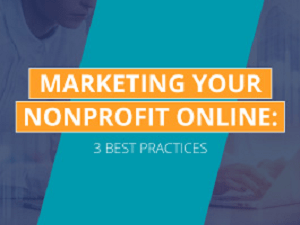
Your nonprofit’s online marketing strategy needs to continually evolve to keep up with modern trends. Keep your approach evergreen with these best practices.
Digital marketing is increasingly competitive for nonprofits, and online fundraising strategies are continually evolving to keep up with new demands in the space. As a result, it’s common for nonprofits to feel like they are chasing trends and operating a step behind their competitors.
While specific marketing strategies will change over time, there are several reliable best practices that will be applicable to most organizations. In this article, we’ll explore three strategies for how to assess, plan, and improve your marketing practices.
We’ll review how to:
- identify your goals;
- integrate your strategies; and,
- partner with a consultant.
Your marketing strategy will evolve as your organization grows, and implementing a system to regularly reassess your current practices will ensure you stay up to date with the latest ongoing trends.
1. Identify your goals.
When refining your digital strategy or creating a new one, your first step should be to establish specific goals outlining how your new strategy will improve on your previous one. To set these goals, first take the time to analyze your current approach, software, and data.
Identify what your current marketing strategy is doing well, where it is falling short, and how your proposed new practices will overcome those challenges. For example, a nonprofit may aim to improve its major donor acquisition and start by reviewing its follow-up process for identifying whether new donors have the capacity to be major giving candidates. This nonprofit might determine that new major gift technology is needed to receive more accurate prospecting data and better facilitate their follow-up process.
Ensure your chosen goal is measurable and has a specific timeline for when you would expect to see improvements. Then, assess your results to determine if any additional changes need to be made to achieve your goal.
2. Integrate your strategies.
Your online marketing strategy likely has several components, including your nonprofit website, social media accounts, and direct email outreach. Your methods for using each of these channels should align to create a cohesive approach to push supporters towards a potential conversion.
Many of your donors are likely digital natives and enjoy interacting with organizations that create personalized experiences. Your nonprofit can appeal to these donors by integrating your strategies and using data collected from one platform to inform your approach on another.
For example, if a donor engages with an event advertisement on your social media account, consider reaching out to them via email with a personalized invitation to that event. This approach helps highlight content donors are likely to engage with, while also crafting an individualized experience.
3. Partner with a consultant.
If your nonprofit intends to completely rehaul your marketing strategy or launch a new campaign, it can be worthwhile to partner with a marketing consultant. The right consultant can provide your team with professional insight to help navigate challenges you may not have initially been aware of and take advantage of new opportunities.
DNL OmniMedia’s guide to nonprofit consulting firms walks through the seven steps for hiring a consultant:
- Review your needs. Prior to beginning the process, determine if you need a consultant and what the consultant will help with specifically. Consider what aspects of your marketing campaign you would like a consultant to assist with and establish goals.
- Attain board buy-in. Complete your needs assessment and present it to your board to attain their buy-in. Partnering with a consultant can be an expensive, long-term assessment, and all major stakeholders should be consulted with ahead of time.
- Set guidelines. Establish a timeline, budget, and other parameters for your consulting partnership. This will be shared with your board and potential consultants.
- Research consultants. Discover prospective consulting firms by requesting referrals from colleagues at other organizations and conducting your own research. Many top consultants can be found online through provider lists organized by specialty.
- Craft your RFP. A request for proposals (RFP) includes your project’s timeline, details, and other expectations.
- Review candidates. Meet with your stakeholders to determine your top candidates. Reach out to these consultants to introduce your nonprofit, then move forward by submitting your RFP.
- Assess proposals. Each consultant will develop a proposal for how they will respond to the situation outlined in your RFP. Work with your stakeholders to assess each consultant’s plan. Then, you can reach out to your chosen consultant to work out a formal contract.
In addition to partnering with a consultant, consider what additional training your team will need to meet your marketing goals. Explore training courses, webinars, and conferences for nonprofit professionals, and determine which of your team members should take the time to receive this training.
- Analyze your current practices and marketing data to find places for improvement.
- Ensure your strategies on each platform are aligned to create a cohesive experience for supporters.
- If you are beginning a new marketing campaign, review your needs to determine if you can benefit from working with a consultant.